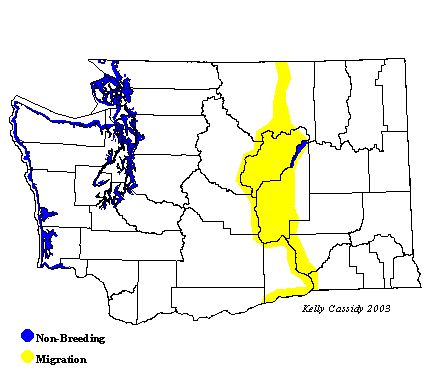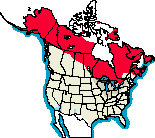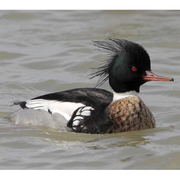Red-breasted Merganser
General Description
The ragged-crested Red-breasted Merganser winters in Washington but breeds farther to the north. The adult male in breeding plumage has a reddish-brown mottled breast, white neck collar, green head, and red eyes. The serrate orange bill is very thin. The back is black and white, and the flanks are gray. The female has an overall gray body, reddish-brown head, and reddish eyes. There is no obvious white chin-patch as in the female Common Merganser. The juvenile is similar to the female but has a white bar across its face. Non-breeding adult males appear similar to females as well.
Habitat
Breeding habitat is in the tundra and boreal-forest zones. Breeding occurs on fresh, brackish, and saltwater wetlands and in sheltered bays. During migration and in winter, Red-breasted Mergansers occur mostly on salt water, in coastal bays, estuaries, and other protected coastal areas.
Behavior
Red-breasted Mergansers are typically found in small flocks, rather than huge rafts. They forage by diving and swimming under water, sometimes in cooperative groups, working schools of fish into shallow water.
Diet
While the young eat mostly aquatic insects, adults primarily eat fish. Crustaceans and other aquatic creatures are also eaten.
Nesting
Females first breed at the age of two years. Pairs generally form in late winter and during spring migration, although some evidence of pairing may be evident in the late fall. Breeding is late in the season, and often the young do not fledge until September. The nest is located in a sheltered spot on the ground, usually near water. It is a simple depression lined with vegetation and down. The female lays 7 to 10 eggs, and sometimes lays eggs in the nests of other females. Males usually leave when incubation begins. Incubation is by the female alone and lasts for 28 to 35 days. Within a day or so of hatching, the young follow the female to water where they feed themselves. Often, in areas of high-density nesting, two or more broods will join and form a crèche, with one or more females tending them. Within a few weeks, the females typically abandon the young, who cannot fly until they are about two months old.
Migration Status
Red-breasted Mergansers usually migrate in pairs or small flocks. Males leave the breeding grounds in mid-summer on their molt migration, but the destinations are not known. Spring migration begins in March and peaks in April, continuing into May. Birds are typically on the breeding grounds by mid- to late May. In the fall, birds start arriving in September, although most birds arrive on the wintering grounds in late November.
Conservation Status
Breeding populations in the North Pacific seem to have increased over the last ten years. Hunting is not a major source of mortality, but a number have been shot illegally due to their suspected impact on salmon and other commercial fish. The extent of their impact is not known, but it is not likely that they are causing significant salmon mortality.
When and Where to Find in Washington
Red-breasted Mergansers can be found during migration on major lakes in eastern Washington, especially at Banks Lake (Grant County). They are much more common in western and coastal Washington during migration and in winter. They are abundant in Puget Sound and the Strait of Juan de Fuca, and in major estuaries along the outer coast.
 Abundance
Abundance
| Ecoregion | Jan | Feb | Mar | Apr | May | Jun | Jul | Aug | Sep | Oct | Nov | Dec |
|---|---|---|---|---|---|---|---|---|---|---|---|---|
| Oceanic | ||||||||||||
| Pacific Northwest Coast | C | C | C | C | C | R | R | R | U | C | C | C |
| Puget Trough | C | C | C | C | U | R | R | R | U | F | C | C |
| North Cascades | R | R | R | R | ||||||||
| West Cascades | R | R | R | R | R | |||||||
| East Cascades | R | R | ||||||||||
| Okanogan | ||||||||||||
| Canadian Rockies | ||||||||||||
| Blue Mountains | ||||||||||||
| Columbia Plateau | R | R | R | R | R | R | R |
Washington Range Map

North American Range Map


Family Members
 Fulvous Whistling-DuckDendrocygna bicolor
Fulvous Whistling-DuckDendrocygna bicolor Taiga Bean-GooseAnser fabalis
Taiga Bean-GooseAnser fabalis Greater White-fronted GooseAnser albifrons
Greater White-fronted GooseAnser albifrons Emperor GooseChen canagica
Emperor GooseChen canagica Snow GooseChen caerulescens
Snow GooseChen caerulescens Ross's GooseChen rossii
Ross's GooseChen rossii BrantBranta bernicla
BrantBranta bernicla Cackling GooseBranta hutchinsii
Cackling GooseBranta hutchinsii Canada GooseBranta canadensis
Canada GooseBranta canadensis Mute SwanCygnus olor
Mute SwanCygnus olor Trumpeter SwanCygnus buccinator
Trumpeter SwanCygnus buccinator Tundra SwanCygnus columbianus
Tundra SwanCygnus columbianus Wood DuckAix sponsa
Wood DuckAix sponsa GadwallAnas strepera
GadwallAnas strepera Falcated DuckAnas falcata
Falcated DuckAnas falcata Eurasian WigeonAnas penelope
Eurasian WigeonAnas penelope American WigeonAnas americana
American WigeonAnas americana American Black DuckAnas rubripes
American Black DuckAnas rubripes MallardAnas platyrhynchos
MallardAnas platyrhynchos Blue-winged TealAnas discors
Blue-winged TealAnas discors Cinnamon TealAnas cyanoptera
Cinnamon TealAnas cyanoptera Northern ShovelerAnas clypeata
Northern ShovelerAnas clypeata Northern PintailAnas acuta
Northern PintailAnas acuta GarganeyAnas querquedula
GarganeyAnas querquedula Baikal TealAnas formosa
Baikal TealAnas formosa Green-winged TealAnas crecca
Green-winged TealAnas crecca CanvasbackAythya valisineria
CanvasbackAythya valisineria RedheadAythya americana
RedheadAythya americana Ring-necked DuckAythya collaris
Ring-necked DuckAythya collaris Tufted DuckAythya fuligula
Tufted DuckAythya fuligula Greater ScaupAythya marila
Greater ScaupAythya marila Lesser ScaupAythya affinis
Lesser ScaupAythya affinis Steller's EiderPolysticta stelleri
Steller's EiderPolysticta stelleri King EiderSomateria spectabilis
King EiderSomateria spectabilis Common EiderSomateria mollissima
Common EiderSomateria mollissima Harlequin DuckHistrionicus histrionicus
Harlequin DuckHistrionicus histrionicus Surf ScoterMelanitta perspicillata
Surf ScoterMelanitta perspicillata White-winged ScoterMelanitta fusca
White-winged ScoterMelanitta fusca Black ScoterMelanitta nigra
Black ScoterMelanitta nigra Long-tailed DuckClangula hyemalis
Long-tailed DuckClangula hyemalis BuffleheadBucephala albeola
BuffleheadBucephala albeola Common GoldeneyeBucephala clangula
Common GoldeneyeBucephala clangula Barrow's GoldeneyeBucephala islandica
Barrow's GoldeneyeBucephala islandica SmewMergellus albellus
SmewMergellus albellus Hooded MerganserLophodytes cucullatus
Hooded MerganserLophodytes cucullatus Common MerganserMergus merganser
Common MerganserMergus merganser Red-breasted MerganserMergus serrator
Red-breasted MerganserMergus serrator Ruddy DuckOxyura jamaicensis
Ruddy DuckOxyura jamaicensis

